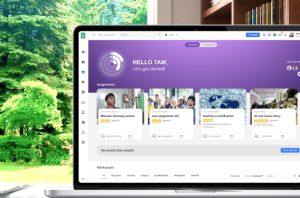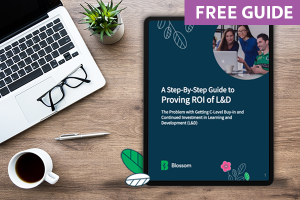Skill sets for jobs have changed by around a quarter since 2015; by 2027, this number is expected to double. Understanding and addressing skills and knowledge shortages is vital for sustained business success. This rapid and substantial shift in the skills required for various roles highlights the need for continuous learning and adaptability in the workplace.
As organisations need to ensure their people have the skills to navigate changing business environments, optimal training decisions require employers to have accurate information about their workers’ training needs.
But how can you identify skills and knowledge gaps in your business? And how do you assess the success of your current strategies in addressing these gaps?
This blog post will help you identify where to focus your efforts in closing these gaps and provide insights into gauging the success of your strategies.
The impact of skills and knowledge gaps
Skill and knowledge gaps refer to situations where workers’ skills are inadequate to fulfill the demands of their present job. This mismatch happens when individuals have too many or too few qualifications or skills for their job.
Distinct from skills shortages that come before hiring takes place, skills and knowledge gaps can lower productivity, as employees may struggle to perform tasks efficiently. These gaps also lead to higher labour costs as organisations need more workers to address shortfalls and meet demand.
Businesses encounter challenges when there’s a mismatch between required and available skills and knowledge. And let’s face it, skills and knowledge gaps cost money. Employers may face additional costs due to the need for extra training and poorly aligning workers with specific projects. This can affect innovation and adaptation to new technologies, limiting a company’s ability to stay competitive.
Plus, frustration from skill gaps can lead to more employees leaving for roles where their skills fit better. Employees may find their career growth hindered if they lack the necessary skills for advancement. As 93% of organisations worry about employee retention, fixing these gaps isn’t just about talent development but a crucial retention effort. Being unable to fulfil job requirements can lead to dissatisfaction and reduced employee motivation.
Create a happier workplace, lessen turnover, and build lasting employee loyalty. Ensure your employees have the right skills and knowledge. By identifying skill and knowledge gaps that reflect the future career aspirations of your workers and meet current job needs, you can tailor training programmes and development initiatives to bridge those gaps, ensuring a skilled and motivated workforce.
Let’s explore seven ways to address and bridge these gaps to increase employee satisfaction, boost employee growth and business success.
1. Leverage learning management systems (LMS)
Begin by assessing the tools and software currently used in your organisation to measure skills and knowledge gaps. Your existing technology may provide inaccurate or incomplete assessments of skills. This can lead to misinterpretation of employees’ actual capabilities, resulting in misguided L&D efforts.
Modular Learning Experience Platforms (LXP), like Blossom, ensure that the skills assessment process is streamlined and efficient. This means you get a quicker and more accurate evaluation of the current skill landscape and is often more cost-effective than investing in entirely new systems.
As Blossom provides real-time data and analytics, you can gain immediate insights into skills gaps, allowing for timely and informed decision-making.
Let’s say a financial consultancy firm noticed increased client complaints about the customer service team’s handling of complex financial queries. This raised concerns about potential knowledge gaps.
Since implementing an LXP, the firm conducted real-time assessments covering financial regulations, investment strategies, and client communication skills.
Comprehensive analytics revealed specific knowledge gaps within the customer service team. This led to organising targeted training sessions to address these gaps, resulting in improved client satisfaction scores and more effective client interactions.
Understand skills and knowledge gaps in your company, tailor interventions, and provide targeted support and resources to address identified gaps. An LMS is a comprehensive tool for delivering training content and collecting valuable data on employee skills and knowledge.
2. Conduct a thorough skills audit
Assess the current skill set of employees to identify strengths, weaknesses, and gaps in knowledge or expertise. This systematic process of evaluating and documenting individuals’ skills, competencies, and qualifications will give you a comprehensive understanding of the skills available within the workforce.
By making informed decisions about training, development, and strategic workforce planning, conducting a skills audit is a valuable tool for aligning employee capabilities with organisational objectives and ensuring that the workforce possesses the skills required for current and future roles.
Regularly assess the skills required for each role in your organisation. Compare these with the skills possessed by your employees. Use the skills audit results to identify areas where training and development opportunities are needed.
Involve key stakeholders in the process, including department heads, team leaders, and employees (more on this next). Their input can provide valuable insights into the skills required for success in various roles.
Use a combination of surveys, interviews, and assessments to gather comprehensive data. This ensures a well-rounded view of individual and collective skills.
Remember: skills audits should be an ongoing process. Regularly update skills inventories to ensure they reflect your business’s and industry’s evolving needs.
3. Include employee feedback and self-assessment tools
Employees know firsthand their daily tasks, challenges, and areas where they need to be more proficient. Involving them allows you to gain insights into individual development needs that might not be apparent through external assessments alone.
Self-assessment and insights from those directly involved in their roles can highlight areas where they feel less confident or need additional training.
Because 85% of employees show increased initiative when provided with feedback on their skills gaps, it fosters a sense of ownership and accountability for their professional development.
Considering that most employees often have personal career goals and aspirations, involving them in the skills assessment process ensures that your L&D initiatives for closing gaps align with individual career objectives. This alignment promotes a win-win scenario where employees enhance their skills while contributing to broader company goals.
Not only that, but employees can provide valuable input into their preferred learning styles, methods, and the pace at which they can comfortably acquire new skills. This information is essential for tailoring L&D plans that resonate with individual preferences.
They may even have hidden talents or skills not fully used within their current roles. Involvement in skills assessment can reveal these hidden strengths, allowing you to leverage and maximise your workforce’s potential.
Encourage your employees to provide feedback on their skills and knowledge. Get valuable feedback on the effectiveness of training programmes and initiatives. Their insights help you identify skills and knowledge gaps and refine learning experiences, ensuring that interventions meet the intended goals.
4. Make use of performance review data
Failure to analyse performance data for skills gaps means missing opportunities for employee growth and advancement. Employees with untapped potential may go unnoticed, risking the potential for overlooking individuals who could excel in higher-level roles with additional training.
Plus, in industries with strict regulatory requirements, such as healthcare and financial services, overlooking skills and knowledge gaps can pose a risk of compliance violations. Employees lacking the necessary knowledge of industry regulations may unintentionally breach compliance standards, exposing an organisation to legal consequences, fines, and reputational damage.
Employee performance review data play a crucial role in addressing skills and knowledge gaps by:
- Identifying strengths and weaknesses. Performance reviews provide a structured platform to assess an employee’s overall performance. This includes identifying their strengths and areas where improvement is needed and highlighting potential skills and knowledge gaps.
- Aligning goals and tracking progress. Through performance reviews, employees’ individual goals and objectives are revisited and aligned with company objectives. This alignment helps track progress toward skill development goals and ensures that employees help meet business priorities.
- Offering a continuous feedback loop. Regular performance reviews create a constant feedback loop between employees and managers. This ongoing communication allows for timely discussions about skills development, addressing any immediate gaps or concerns before they become significant issues.
- Developing individual development plans. Performance reviews form part of personal development plans. By identifying specific skills and knowledge areas that require improvement, businesses can tailor development plans to meet the unique needs of each employee, promoting targeted skill enhancement.
- Recognising achievements. Positive feedback boosts morale and motivation, while constructive feedback provides insights into areas where additional training or development may be necessary.
Performance reviews offer objective criteria for evaluating employees’ contributions. This transparent view of employees’ skills and knowledge gaps helps pinpoint areas for improvement and strengths to capitalise on. By aggregating information from multiple reviews, you and your teams can identify common trends and use this data to create specific training programmes for widespread skills gaps.
5. Benchmark against industry standards
Industry standards reflect the best practices and ideal skill levels. Comparing your workforce to these standards helps identify gaps and align your team with industry best practices. This ensures that employees perform at the highest standards, enhancing customer satisfaction and loyalty by meeting or surpassing industry norms.
In addition, benchmarking allows organisations to demonstrate their competence to stakeholders, including clients, partners, and investors. Build trust and credibility in your ability to deliver high-quality products or services by showcasing that the workforce aligns with or exceeds industry standards. Critical for demonstrating the return on investment for your L&D efforts.
Plus, when recruiting new talent, benchmarking against industry standards guides the hiring process. It helps define the desired skill set for potential candidates, ensuring that new hires bring the skills needed to meet or surpass industry benchmarks.
Why not engage with industry associations, forums, or networks? These platforms often provide insights into evolving industry standards. Collaborate with professionals in your industry to understand current trends and expectations to identify critical skill shortages compared to industry norms. This awareness allows for strategic workforce planning and ensures that your organisation is not lagging in essential skills.
6. Complete job analysis
Get a complete understanding of job roles by completing a job analysis. Understand the skills and competencies needed for each job role and design targeted training and development programmes.
Job analysis helps develop the criteria for recruitment and selection processes. It helps identify the necessary skills, qualifications, and attributes for successful job performance, leading to more informed hiring decisions. This knowledge gives you the skills and qualifications required for critical positions and identifies potential employees poised for promotion.
Furthermore, job analysis also identifies potential workplace hazards and risks associated with specific job roles. If we consider a machine operator role, job analysis breaks down tasks. Potential risks are identified, such as exposure to moving machine parts and noise levels–leading to the development of targeted safety protocols. These findings may prompt the implementation of safety training programmes and ensure that employees in the machine operator role are well-informed and equipped to maintain a safe work environment, aligning with health and safety regulations.
Blossom can help you complete a comprehensive job analysis. Certification tracking features, for example, can monitor certifications and qualifications related to job roles, ensuring compliance with industry standards.
7. Monitor project performance
Consistent challenges or shortcomings in project performance may indicate specific skill deficiencies within the team. For example, if a team consistently struggles with meeting deadlines or delivering quality outcomes, it could point to gaps in time management, technical proficiency, or other relevant skills.
These patterns of underperformance in certain areas highlight where additional training or upskilling may be necessary. This information guides HR and L&D teams in tailoring training programmes to address specific skills gaps, ensuring employees have the capabilities needed for successful project completion.
Blossom can simplify workforce organisation and process management by providing tools to plan, manage, and monitor projects within and across teams. With its capabilities to track project performance, assess the success of initiatives, and identify consistent challenges or shortcomings, Blossom is a valuable asset in addressing skills gaps.
For instance, if project assessments reveal recurring issues related to specific skills or knowledge areas, use this information to tailor training programmes or implement targeted interventions to bridge the identified gaps.
Why not include customer feedback during project performance analysis? You may uncover recurring issues or requests where employees need additional skills or knowledge to serve customer needs better.
Take a proactive approach to identifying employee skills and knowledge gaps
Identify employee skills and knowledge gaps and build a capable and efficient workforce.
Ensure your employees have the necessary capabilities for roles now and in the future. Follow the steps mentioned here and pinpoint areas where employee skills and knowledge may be lacking. This deep understanding will allow you to understand where to focus your L&D efforts–helping you take a proactive stance to develop targeted interventions and training programmes to bridge gaps.
Blossom can help your organisation identify skills and knowledge gaps. Schedule a demo today with one of our friendly experts.








